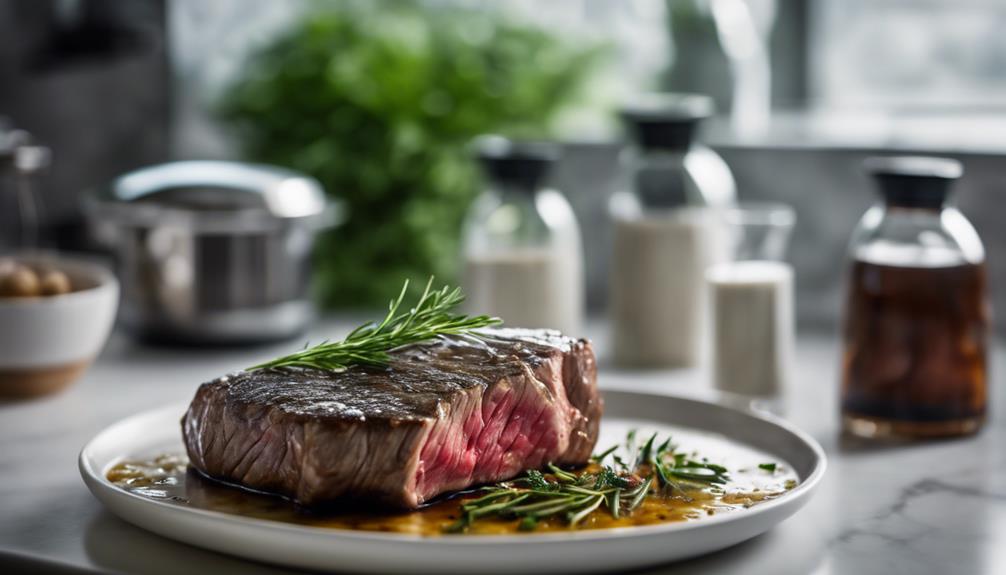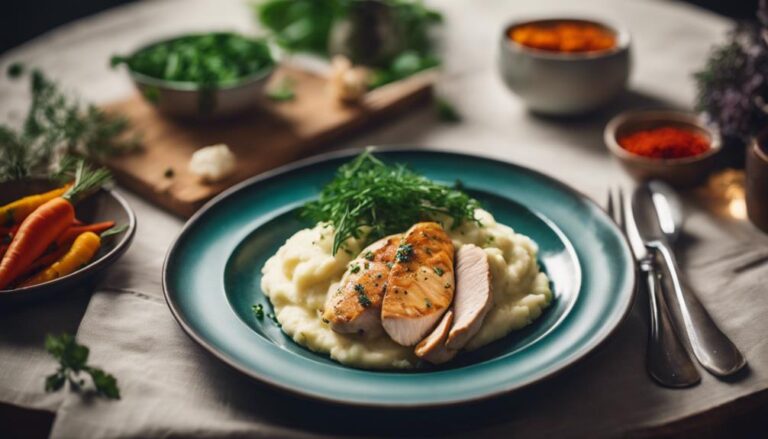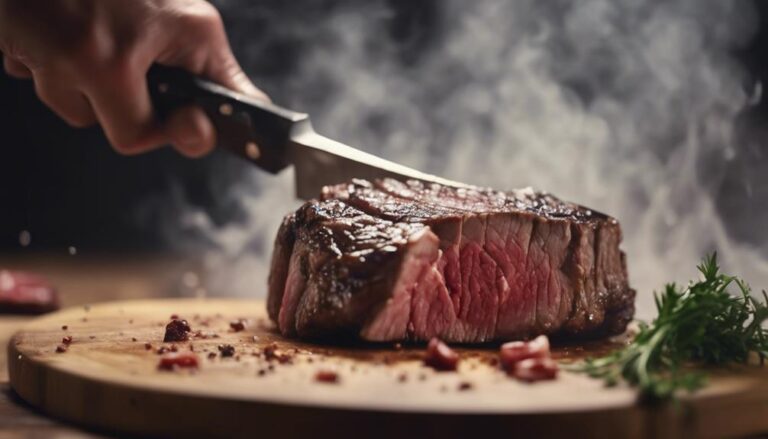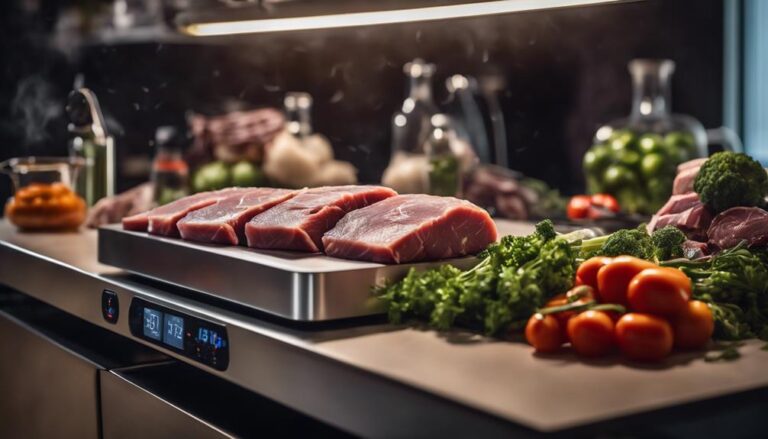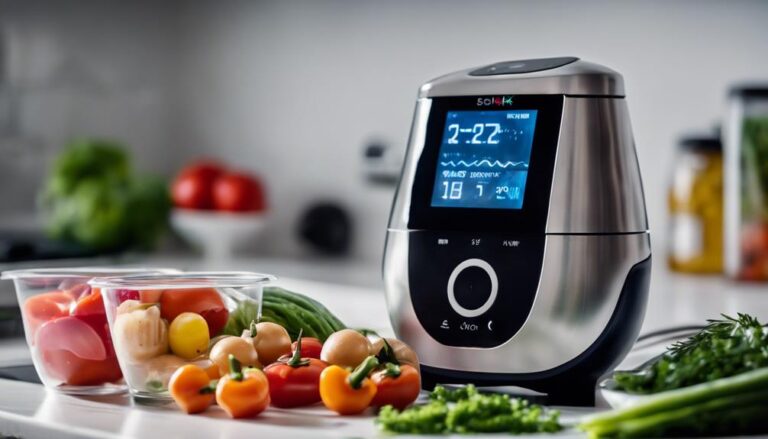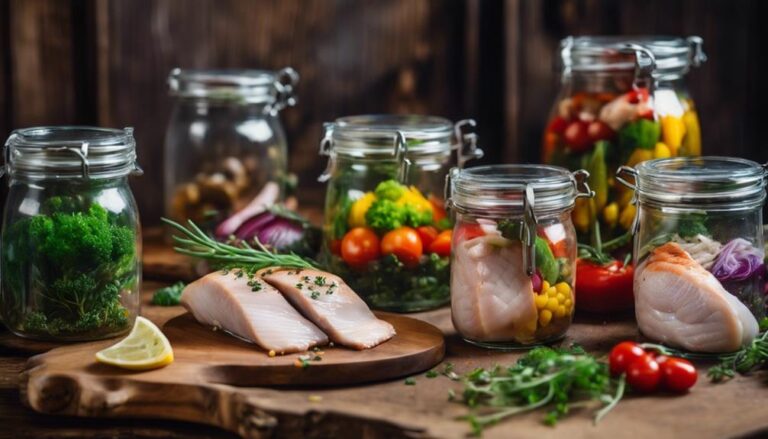How to Sous Vide Lean Cuts of Meat Perfectly Every Time
To sous vide lean cuts of meat, like chicken breasts and pork tenderloin, start by seasoning generously and sealing them in vacuum bags. Use an immersion circulator to maintain a water temperature between 129°F to 135°F for ideal moisture retention. Cook for 1 to 2 hours for chicken and slightly longer for thicker cuts of pork. After cooking, finish by searing in a hot skillet for added flavor. Remember to check for proper sealing to avoid contamination. Following these guidelines will guarantee your meat is juicy and tender. You'll discover even more helpful tips and techniques ahead.
What You Will Learn Here
- Set sous vide temperature between 129°F to 135°F and cook lean cuts for 1-4 hours to maintain moisture and tenderness.
- Generously season meat before vacuum sealing to enhance flavor without overpowering the natural taste.
- Use high-quality vacuum-sealed bags to prevent water infiltration and maintain even heat distribution during cooking.
- Monitor cooking times based on meat thickness to avoid overcooking and ensure desired doneness.
Understanding Lean Cuts of Meat
Lean cuts of meat, like chicken breasts and pork tenderloin, pack less fat, making them prone to drying out if not cooked carefully.
When you choose sous vide cooking for these cuts, you reveal the potential for ideal moisture retention and tenderness. The ideal cooking temperature for lean cuts ranges from 129°F to 135°F, ensuring they remain juicy while developing robust flavors.
Cooking times generally vary from 1 to 4 hours, but for the best results, aim for 2 to 3 hours. This timeframe helps maintain juiciness without risking overcooking.
As you prepare your lean cuts, remember that seasoning plays a vital role. With less fat to enhance flavor, you'll want to use spices and herbs generously to elevate the taste.
Sous vide cooking offers precise temperature control, greatly reducing the chances of overcooking compared to traditional methods.
Essential Equipment for Sous Vide
To achieve perfect sous vide results, you'll need a few essential pieces of equipment that guarantee precise cooking and flavor retention.
The first item is an immersion circulator, which maintains a consistent water temperature for even cooking of lean cuts of meat. It's crucial for achieving the ideal texture and juiciness.
Next, you'll require a vacuum sealer or heavy-duty resealable bags. These create an airtight seal, preventing water from entering and locking in those wonderful flavors during the cooking process.
A large, heat-safe container or pot is also necessary to hold the water bath, making sure your meat is fully submerged without crowding.
To verify the accuracy of your immersion circulator's temperature settings, a digital thermometer can be helpful, as it guarantees peak cooking conditions for those lean meats.
Preparing Meat for Sous Vide
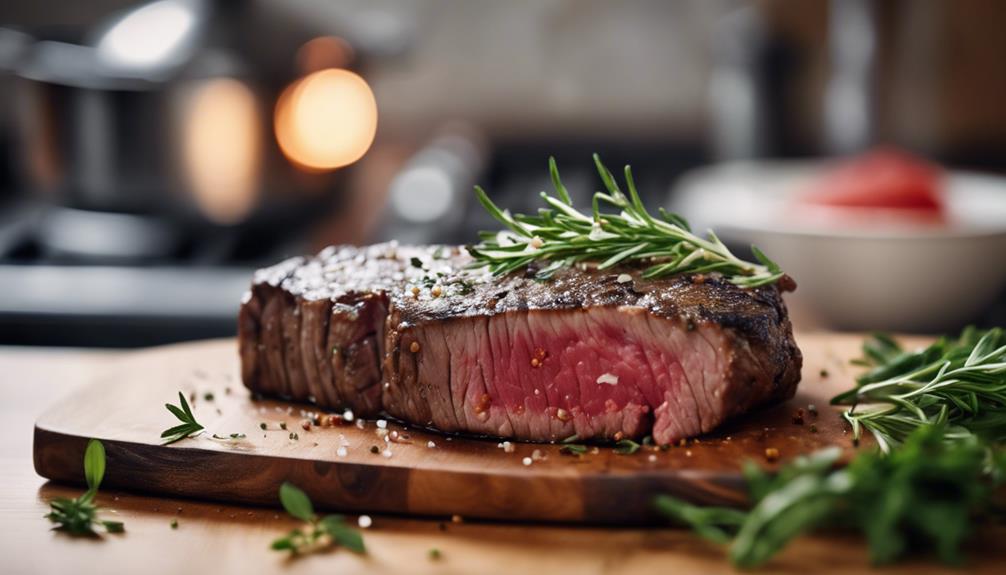
After gathering your sous vide equipment, the next step is preparing the meat for cooking.
Begin by trimming excess fat from lean cuts, like chicken breasts or pork tenderloin. This guarantees even cooking and helps retain moisture without making the dish greasy.
Next, season the meat generously with salt and pepper, or use a spice rub. Let it sit for about 30 minutes to enhance flavor before vacuum sealing.
For an extra flavor boost, consider adding aromatics, such as garlic, fresh herbs like thyme or rosemary, or citrus zest into the vacuum bag along with the meat.
Use high-quality, food-safe vacuum-seal bags to prevent contamination and guarantee a tight seal that locks in moisture and flavors during the cooking process.
Make certain your meat is at least 1.5 inches thick to achieve ideal sous vide results. This thickness helps maintain the desired texture and doneness throughout the cooking.
Ideal Temperatures and Times
Sous vide cooking requires precise temperatures and times to guarantee your meat turns out perfectly tender and flavorful.
For lean meats like chicken breasts and pork tenderloin, you'll want to set your sous vide machine at 145°F (63°C). Cook these cuts for 1-2 hours to achieve a juicy, tender result while ensuring they reach safe internal temperatures.
If you're preparing turkey breast, aim for 140°F (60°C) and cook for 2-4 hours. This will help maintain moisture and flavor. Remember, the cooking time can vary based on thickness; for cuts around 1.5 inches thick, shorter times of 1-2 hours work well, while thicker cuts may need longer cooking times.
Consistent temperature control in sous vide cooking is essential, as it prevents drying out your lean meats, ensuring they remain moist and delicious.
By mastering these ideal temperatures and sous vide cooking times, you'll serve perfectly cooked dishes every time. Don't forget to make any necessary time adjustments based on the specific thickness of your cuts, as this can greatly impact the final result.
Enjoy the satisfaction of serving tender, flavorful meals to your guests!
Cooking Techniques for Lean Meat
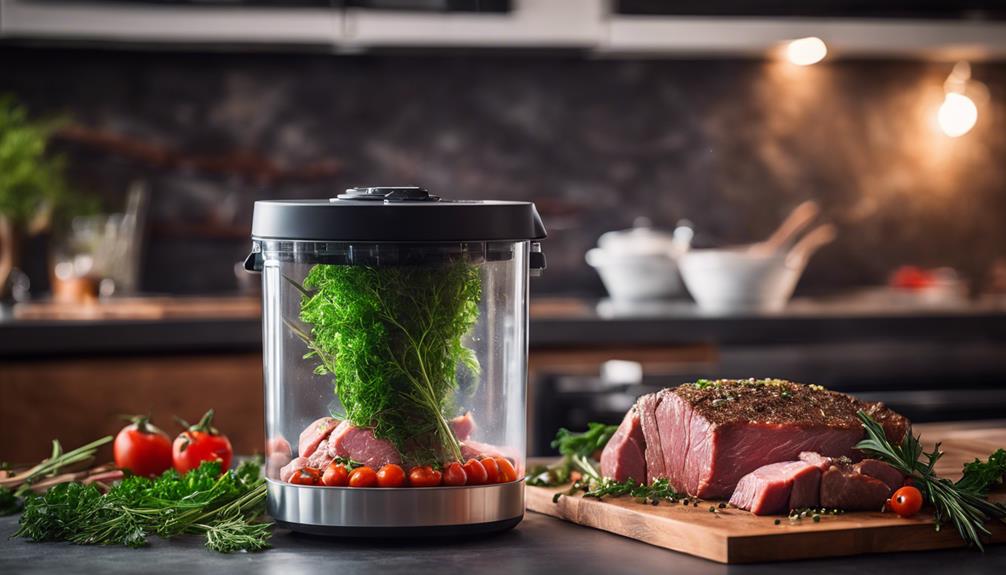
Cooking lean meats requires specific techniques to guarantee they stay moist and flavorful while achieving the perfect texture. When you're preparing lean cuts of meat, like chicken breasts or pork tenderloin, sous vide cooking is your best friend. By cooking at the right temperatures, you can maintain moisture and tenderness without the risk of overcooking.
Here are some key techniques to keep in mind:
- Season generously: Lean meats lack fat, so enhance their flavor by seasoning well before sealing them in vacuum bags.
- Monitor cooking time: Stick to recommended cooking durations—typically 1-2 hours at 145°F (63°C)—to ensure ideal tenderness.
- Maintain ideal temperatures: Cook at temperatures between 129°F to 160°F to preserve moisture and prevent drying out.
Finishing Techniques for Added Flavor
Finishing your lean cuts of meat with a quick sear or grill can elevate their flavor and texture, making your dish truly exceptional. After sous vide cooking, it is crucial to develop a flavorful crust without overcooking the interior. Here's a quick guide to some effective finishing techniques:
| Technique | Description | Key Benefits |
|---|---|---|
| Searing | Quickly cook in a hot skillet for 1-2 minutes per side. | Creates a flavorful crust. |
| Grilling | Preheat the grill and sear for 1-2 minutes on each side. | Imparts a smoky flavor. |
| Torch Searing | Use a torch for high-temperature searing. | Achieves caramelization on the exterior. |
| Adding Aromatics | Include fresh herbs or garlic during the searing. | Enhances the flavor profile. |
Resting the meat for a few minutes after finishing allows the juices to redistribute, ensuring your final dish is juicy and full of flavor. Incorporating these finishing techniques not only makes your lean cuts shine but also impresses your guests with vibrant aromas and textures. Enjoy serving flavorful, perfectly cooked meat that reflects your culinary skills!
Tips for Achieving Perfect Results
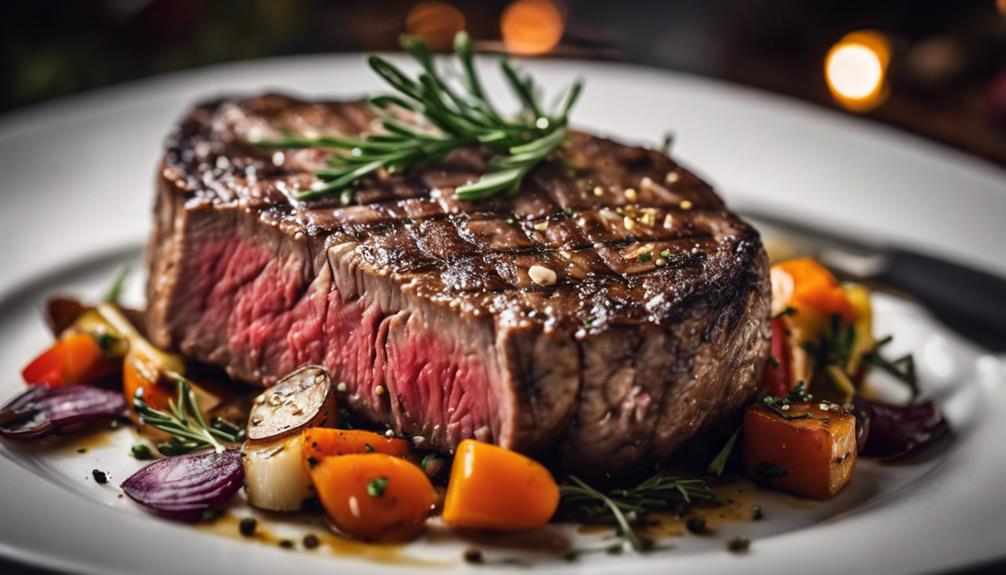
Achieving perfect results with lean cuts of meat requires careful attention to temperature, time, and seasoning. Using the Sous Vide method guarantees that your chicken breasts or pork tenderloin come out moist and flavorful. Here are some tips to help you along the way:
- Cook at the Right Temperature: For lean cuts, aim for 145°F (63°C) for 1-2 hours to prevent dryness.
- Use a Vacuum-Sealed Bag: This helps retain moisture and flavor during cooking, enhancing the overall taste.
- Season Generously: Since lean cuts have less fat, they benefit from stronger seasoning. Don't hesitate to use salt and pepper liberally.
Additionally, consider adding herbs or marinades to the vacuum-sealed bag for maximum flavor infusion. This allows the flavors to penetrate deeply, resulting in a dish that's not only delicious but also impressive when served to others.
With these tips, you can confidently achieve perfect results every time you sous vide lean cuts of meat. Enjoy the process and the wonderful meals you'll create!
Common Mistakes to Avoid
Avoiding common mistakes is essential for ensuring your sous vide lean cuts of meat turn out tender and flavorful.
One major pitfall is cooking at excessively high temperatures. Stick to a range of 129-135°F to maintain moisture retention and avoid dryness. When it comes to cooking time, aim for 1-4 hours; this duration allows you to achieve the desired tenderness without risking overcooking.
Be mindful of seasoning, too. While lean cuts benefit from robust flavors, over-seasoning can overpower their natural taste. Seasoning should be balanced and applied before sealing in food-safe vacuum-sealed bags.
Monitoring cooking time is vital, especially for thin cuts, as they require shorter durations to keep their juiciness intact.
Remember that improper sealing can lead to uneven heat distribution and compromise food safety, so always use high-quality vacuum-sealed bags.
Frequently Asked Questions
Can You Sous Vide 3 Steaks at Once?
Yes, you can sous vide three steaks at once. Just guarantee they're similar in thickness for even cooking. Control temperature, monitor cooking time, and consider seasoning methods to enhance flavor infusion before serving.
Why Is My Steak Still Tough After Sous Vide?
If your steak's still tough after sous vide, check the meat thickness, cooking time, and sous vide temperature. Confirm proper vacuum sealing, allow a resting period, and consider cut selection and seasoning methods for better flavor infusion.
Does Longer Sous Vide Make Meat More Tender?
Longer sous vide cooking can enhance tenderness through proper timing, but too much duration may compromise meat quality. Focus on temperature effects and muscle fibers to achieve desired flavor enhancement without overcooking your chosen meat cuts.
How Long Should You Sous Vide a Thin Steak For?
For a thin steak, sous vide timing should be 1 to 2 hours at 129°F for medium-rare. Season well for flavor infusion, and adjust cooking temperatures based on your ideal doneness and meat types.
Conclusion
Sous vide cooking is a great way to prepare lean cuts of meat, ensuring they stay tender and flavorful.
By understanding the right temperatures, cooking times, and finishing techniques, you can achieve restaurant-quality results at home.
Remember to avoid common mistakes, and you'll build confidence in your sous vide skills.
With practice, you'll find that cooking lean meat can be both simple and rewarding, making it a perfect choice for healthy meals.
Enjoy your culinary journey!
